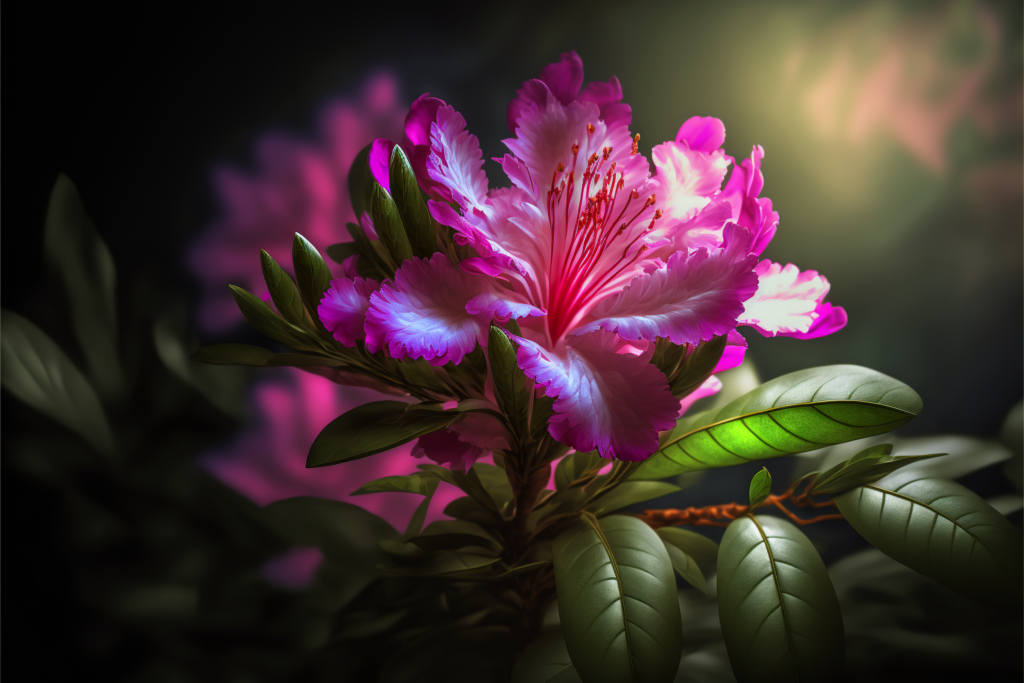While I study plant biotechnology, I often think about how bad it is for nature when people don’t know enough about it or spread false information. That is why I am so passionate about bringing people and nature closer together again. Favourite fruit: raspberries, strawberries and pineapple Favourite vegetables: courgettes, broccoli and cucumbers.
Rhododendron blooms are a favourite among many gardeners. However, to ensure lush flowering it must be properly cared for and protected from disease. Find out all about rhododendron care.
Rhododendrons (Rhododendron) are one of the largest genera within the heath family (Ericaceae). With more than 1,000 species worldwide, the rhododendron is geographically represented almost everywhere. Therefore, it is not surprising that it can be affected by a variety of pests and diseases. We give you advice on how to take good care of your rhododendron and keep pests and diseases away so it can keep blooming beautifully.
Rhododendrons are relatively easy to care for. However, they do require some attention from you at certain times of the year. We reveal what you should pay attention to when caring for them. Before we start, though, there are a few things you should think about before you even plant a rhododendron. Rhododendrons prefer a slightly acidic soil and detest waterlogging. However, many soils, especially in southern Germany, tend to be neutral to slightly alkaline. So, it might be best to make a big hole for planting and fill it with special rhododendron soil.
Rhododendron plants require regular watering, particularly when they are still small. But waterlogging should not happen because the rhododendron is a shrub with shallow roots and is very sensitive to it. There is less need to water a rhododendron as it gets bigger and older because the roots are stronger. Signs of the need for watering may be drooping buds during flowering, or else curling leaves.
Note: water your precious plant at slightly longer intervals but with a little more water. During dry spells in particular, too small amounts of water can evaporate quickly before penetrating the soil.
Rhododendrons are especially happy with long-term fertilisation. The best time for this is in the spring, which means shortly after planting for freshly planted shrubs. Work the fertilizer into the root zone from the top down so that the nutrients can be better absorbed by the soil. To help the plants grow, mix bone meal, compost, and/or coffee grounds with the soil you dug up and then put it back in the hole you dug. All of these fertilizers are completely natural, make the soil a little more acidic, and help the plants and animals that live there. While coffee grounds lower the pH of the soil, they are not a great source of nutrients. Compost, on the other hand, provides nutrients over a long period of time. Bone meal does not affect soil pH but also provides long-term nutrient release with a high nitrogen content. If you’d rather not use slow-release fertilizers and instead fertilize your plants regularly, stop fertilizing in early October to make the plants go into dormancy.
Giving your favorite shrubs that are already well established in the garden a mix of mineral and organic fertilizer a few weeks before they flower is what experts say you should do. Learn more in this video.
You can also buy rhododendron fertilizers that are made just for this plant. These fertilizers have all the nutrients it needs and also add back some fully organic nutrients over time. A plant-based fertiliser such as our Plantura Hydrangea Food is also suitable for rhododendrons. The rhododendron gets its nutrients from the slow-release fertilizer over a longer period of time. It also gives the plant iron.
Note: Under special circumstances, a second fertilisation may also be carried out in the summer. This is only needed if the plant’s leaves turn yellow and die because it doesn’t have enough nutrients.
In principle, rhododendrons do not need special pruning to bloom profusely. But over time, the shoots will become more lignified, so it makes perfect sense to do rejuvenation pruning as needed. You should do radical rejuvenation pruning on your rhododendron before it flowers so that you don’t waste its energy and so that nesting birds aren’t disturbed.
Cut off any old shoots with sharp rose shears so that the bush’s bare interior can get light again. It is important to make sure that you cut the shoots at an angle. If this happens, dew or rainwater won’t be able to gather on the shoots’ open parts, which could let diseases in. You can do a full maintenance pruning right after flowering if you don’t want to do a radical rejuvenation pruning but still want to keep the shape of your rhododendron. This means cutting off any shoots that are unsightly, sick, or hurt until you are happy with the way your favorite plant grows again.
Rhododendrons are beautiful shrubs that add vibrant color to any garden with their showy blooms. However, caring for these plants does require some specific knowledge, especially when it comes to watering. Understanding how often to water rhododendrons is key to keeping them happy and flowering profusely season after season. In this comprehensive guide, we’ll cover everything you need to know about watering rhododendron plants successfully.
An Overview of Rhododendron Water Needs
Rhododendrons prefer evenly moist, well-drained soil. Their roots are very fine and sensitive, so both overwatering and underwatering can cause issues. As a general rule, rhododendrons need about 1-1.5 inches of water per week from either rainfall or irrigation. This amount may need to be adjusted based on your climate, the plant’s location, and the time of year.
During the growing season rhododendrons require frequent watering especially when they are blooming and as new growth emerges. However, it’s important to cut back on watering in fall and winter when the plants are dormant. Waterlogged soil during colder months can damage rhododendron roots.
Signs Your Rhododendron Needs Water
The best way to know if your rhododendron needs water is to assess the soil moisture and watch for visual cues from the plant
- Soil feels dry 1-2 inches below the surface
- Leaves appear dull, droopy or curled inward
- Buds and blooms look shriveled
- New growth seems stunted
If you notice any of these signs, it’s time to thoroughly water your rhododendrons. Waiting until you see drought stress will result in less vigorous plants and fewer flowers.
How to Water Rhododendrons Effectively
When watering rhododendrons, aim to moisten the entire root zone without saturating the soil. Here are some tips:
- Water deeply – Rhododendrons have shallow, spreading root systems. Apply water slowly and deeply to reach the roots, not just the surface.
- Use soaker hoses or drip irrigation – These targeted watering methods are ideal for avoiding leaf diseases while thoroughly watering the soil. Overhead watering can promote fungal issues.
- Water early in the day – Watering in the morning allows the foliage to dry out during the day, preventing disease.
- Add mulch – A 2-4 inch layer of mulch conserves moisture and regulates soil temperature. Organic options like pine needles and bark work well.
- Check drainage – Ensure beds have good drainage so excess water can flow through the soil. Rhododendrons are sensitive to wet feet.
How Often to Water Rhododendrons by Season
Watering frequency for rhododendrons varies based on the time of year. Here are some general guidelines:
Spring
- Newly planted rhododendrons need watering 2-3 times per week while establishing.
- Established rhododendrons need water 1-2 times per week as growth resumes and blooming occurs.
- Increase frequency during dry, warm periods or in windy areas where soil dries out faster.
Summer
- Water established rhododendrons 1-2 times per week.
- Check soil frequently, watering anytime the top few inches become dry. Drought stress can cause leaf scorch.
- Newly planted rhododendrons may still need watering 2-3 times per week in hot weather.
Fall
- Begin tapering off water as temperatures cool and growth slows, watering every 7-10 days.
- Continue checking soil moisture and water if the top few inches become dry.
- Avoid overwatering as rhododendrons prepare for dormancy.
Winter
- Water deeply once every 3-4 weeks if rainfall is lacking, moistening the entire root zone.
- Avoid waterlogging the soil, which can damage dormant roots.
- Reduce frequency if soil remains moist. Rhododendrons use very little water while dormant.
Other Watering Tips
- Container-grown rhododendrons may need more frequent watering, even daily in summer heat.
- Sheltered rhododendrons in warmer climates have higher water needs than those in cooler coastal areas.
- Monitor newly planted rhododendrons closely, watering whenever the top inch of soil dries out.
- Rhododendrons in sandy soils require more frequent watering than those growing in clay soil.
- Ensure proper drainage and amend dense, compacted soils to improve water penetration to the roots.
By understanding rhododendron water requirements, providing adequate irrigation, and adjusting your schedule seasonally, you can maintain ideal soil moisture. Adequate water is crucial for growing vibrant, flowering rhododendron plants. Pay close attention to your plants and implement the watering best practices outlined here for success with these iconic garden shrubs.
You want to know who’s behind Plantura?

While I study plant biotechnology, I often think about how bad it is for nature when people don’t know enough about it or spread false information. That is why I am so passionate about bringing people and nature closer together again. Favourite fruit: raspberries, strawberries and pineapple Favourite vegetables: courgettes, broccoli and cucumbers.
Rhododendron blooms are a favourite among many gardeners. However, to ensure lush flowering it must be properly cared for and protected from disease. Find out all about rhododendron care.
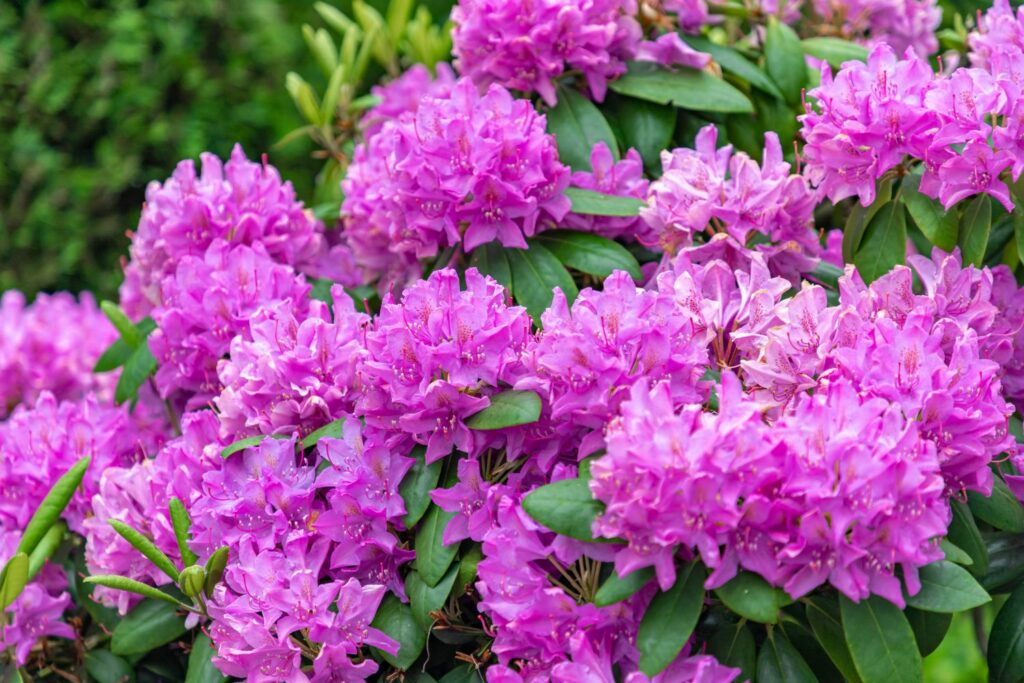
Rhododendrons (Rhododendron) are one of the largest genera within the heath family (Ericaceae). With more than 1,000 species worldwide, the rhododendron is geographically represented almost everywhere. Therefore, it is not surprising that it can be affected by a variety of pests and diseases. We give you advice on how to take good care of your rhododendron and keep pests and diseases away so it can keep blooming beautifully.
Rhododendrons are relatively easy to care for. However, they do require some attention from you at certain times of the year. We reveal what you should pay attention to when caring for them. Before we start, though, there are a few things you should think about before you even plant a rhododendron. Rhododendrons prefer a slightly acidic soil and detest waterlogging. However, many soils, especially in southern Germany, tend to be neutral to slightly alkaline. So, it might be best to make a big hole for planting and fill it with special rhododendron soil.
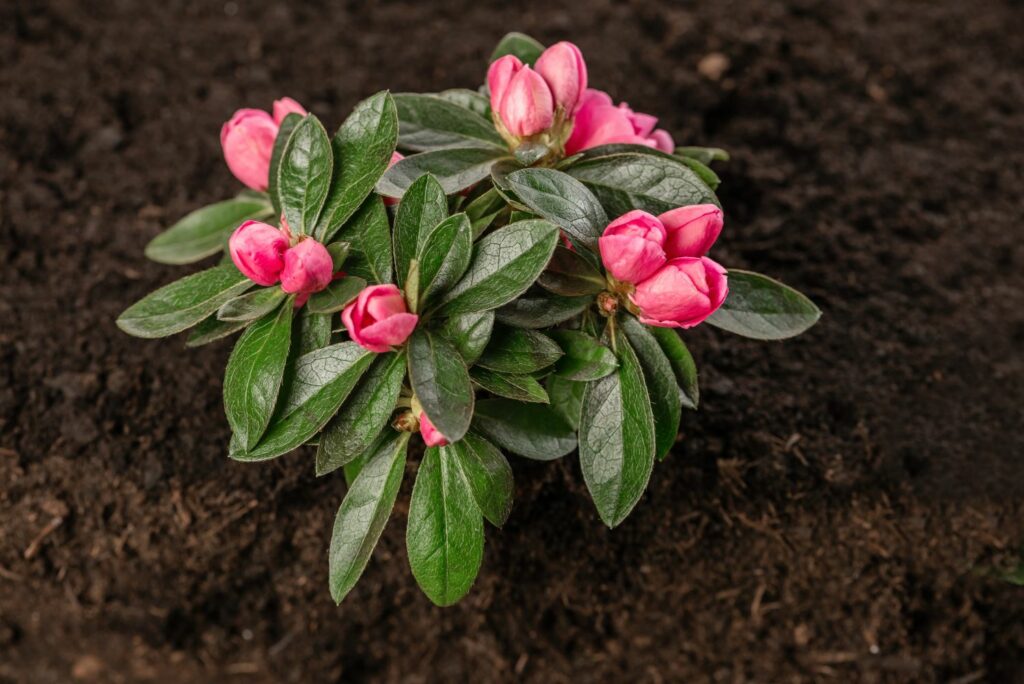
Rhododendron plants require regular watering, particularly when they are still small. But waterlogging should not happen because the rhododendron is a shrub with shallow roots and is very sensitive to it. There is less need to water a rhododendron as it gets bigger and older because the roots are stronger. Signs of the need for watering may be drooping buds during flowering, or else curling leaves.
Note: water your precious plant at slightly longer intervals but with a little more water. During dry spells in particular, too small amounts of water can evaporate quickly before penetrating the soil.
Rhododendrons are especially happy with long-term fertilisation. The best time for this is in the spring, which means shortly after planting for freshly planted shrubs. Work the fertilizer into the root zone from the top down so that the nutrients can be better absorbed by the soil. To help the plants grow, mix bone meal, compost, and/or coffee grounds with the soil you dug up and then put it back in the hole you dug. All of these fertilizers are completely natural, make the soil a little more acidic, and help the plants and animals that live there. While coffee grounds lower the pH of the soil, they are not a great source of nutrients. Compost, on the other hand, provides nutrients over a long period of time. Bone meal does not affect soil pH but also provides long-term nutrient release with a high nitrogen content. If you’d rather not use slow-release fertilizers and instead fertilize your plants regularly, stop fertilizing in early October to make the plants go into dormancy.

Giving your favorite shrubs that are already well established in the garden a mix of mineral and organic fertilizer a few weeks before they flower is what experts say you should do. Learn more in this video.
You can also buy rhododendron fertilizers that are made just for this plant. These fertilizers have all the nutrients it needs and also add back some fully organic nutrients over time. A plant-based fertiliser such as our Plantura Hydrangea Food is also suitable for rhododendrons. The rhododendron gets its nutrients from the slow-release fertilizer over a longer period of time. It also gives the plant iron.
Note: Under special circumstances, a second fertilisation may also be carried out in the summer. This is only needed if the plant’s leaves turn yellow and die because it doesn’t have enough nutrients.
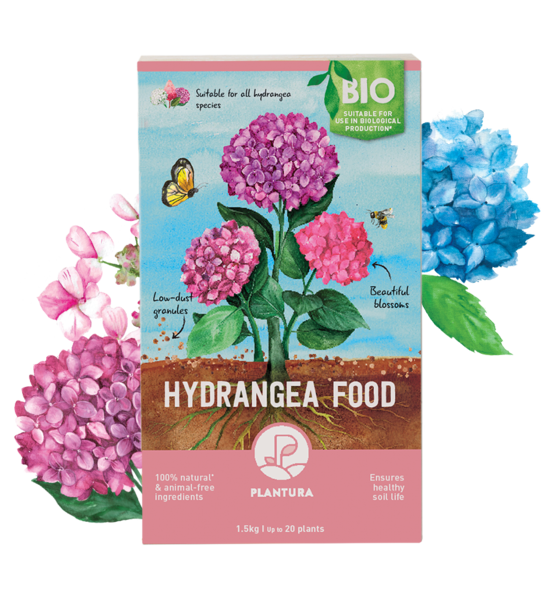
- For lovely hydrangeas in pots with lots of blooms
- Prevents common deficiency symptoms & supports healthy plant growth
- Child-safe fertilizer that lasts a long time and doesn’t contain any animal products
You can find out more about how to properly fertilise your rhododendrons here.
In principle, rhododendrons do not need special pruning to bloom profusely. But over time, the shoots will become more lignified, so it makes perfect sense to do rejuvenation pruning as needed. You should do radical rejuvenation pruning on your rhododendron before it flowers so that you don’t waste its energy and so that nesting birds aren’t disturbed.
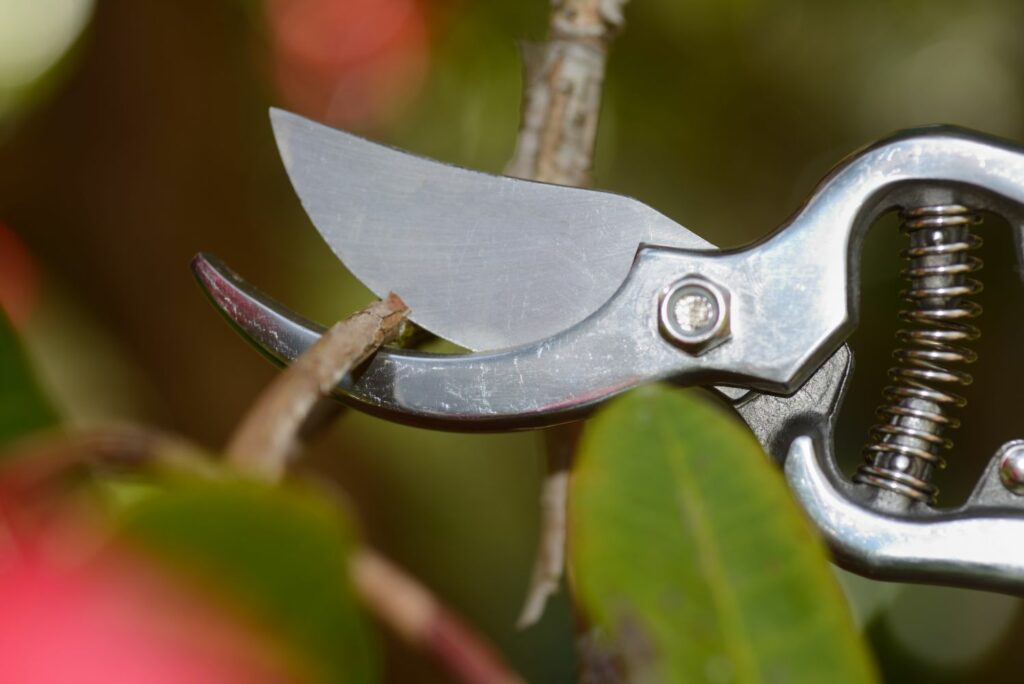
Cut off any old shoots with sharp rose shears so that the bush’s bare interior can get light again. It is important to make sure that you cut the shoots at an angle. If this happens, dew or rainwater won’t be able to gather on the shoots’ open parts, which could let diseases in. You can do a full maintenance pruning right after flowering if you don’t want to do a radical rejuvenation pruning but still want to keep the shape of your rhododendron. This means cutting off any shoots that are unsightly, sick, or hurt until you are happy with the way your favorite plant grows again.
We have put together more tips and tricks for pruning your rhododendron here.
After flowering: deadheading rhododendron flowers
After you have done a comprehensive pruning, you can still continue to do something good for your rhododendron. To do this, simply deadhead all the withered flowers on the remaining shoots. This promotes bud formation the next year and eliminates spore foci, which prevents infestation by fungal pathogens.
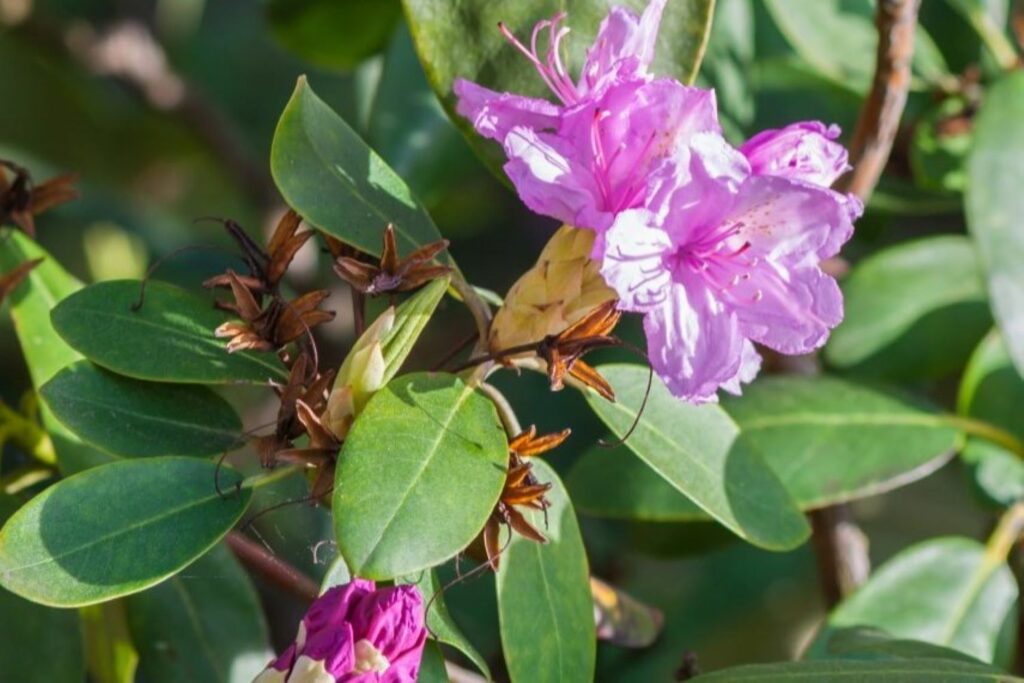
The rhododendron genus is especially prone to fungal diseases, but animal pathogens can also do a lot of damage to its evergreen leaves.
How Often to Water Rhododendron: Your Ultimate Guide
Do rhododendrons need a lot of water?
If the weather is unusually hot and dry, you may need to water your rhododendrons more often. Pay close attention to the soil and if it feels dry, water it immediately. Finally, make sure to water your rhododendrons at their roots and not on their leaves. Wet leaves are more prone to disease and can damage the plant.
How often should you water rhododendrons?
Here are some tips on how often you should water your rhododendrons during the growing season. First, it’s important to know when the growing season for rhododendrons is. Generally, this is from late spring through late summer. During this time, your rhododendrons should be watered deeply and regularly.
Should rhododendrons be watered in the morning?
Water your rhododendrons early in the morning. Watering your rhododendrons in the morning will allow the water to soak into the soil before the hottest part of the day. Rhododendrons will be able to absorb the water more quickly and efficiently. Check the soil before watering. Before you water your rhododendrons, make sure to check the soil.
How do I know if my Rhododendron needs watering?
The best way to gauge rhododendron watering needs is to check the moisture level of the soil by inserting your finger about an inch deep. If the soil feels dry, it’s time to water. However, if the soil feels moist, hold off on watering until it dries out a bit. Take into account the rainfall in your area during the fall.
- The Ultimate Guide to Growing Strawberries in Raised Beds - August 8, 2025
- No-Dig Garden Beds: The Easiest Way to Grow a Beautiful Garden - August 6, 2025
- How to Protect and Preserve Wood for Raised Garden Beds - August 6, 2025

